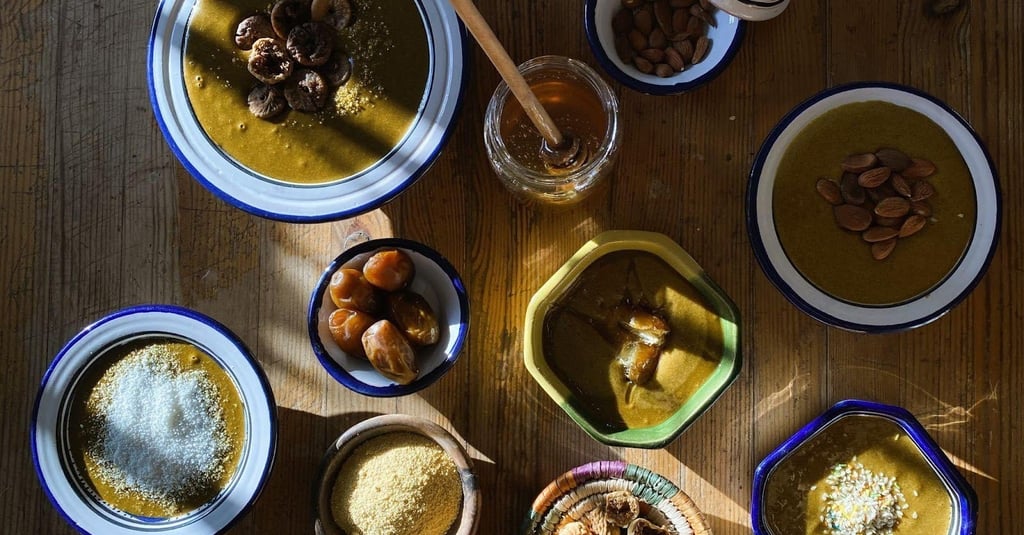Aṭmmin/ⴰⵟⵎⵎⴻⵏ – The Nourishing Tradition of Ifran
In the highlands of Ifran/Yefren in the Infusen/Nefussa region where the land meets the sky and traditions run deep, Aṭmmin (ⴰⵜⵎⵎⴻⵏ) has long been a staple in homes and gatherings. More than just a dish, it is a tradition, a moment of sharing, and a link to the past. With its rich, earthy flavors and smooth yet textured consistency, Atmmin embodies the balance between sustenance and simplicity, offering warmth and nourishment to those who prepare and enjoy it.


In the highlands of Ifran, where the mountains meet the sky and the echoes of tradition persist in every valley ,Aṭmmin (ⴰⵜⵎⵎⴻⵏ) stands as more than just a dish—it is a legacy, a communal experience, and a connection to the land. For generations, this humble yet deeply sustaining food has been a pillar of daily life, crafted from the simplest of ingredients yet rich in symbolism. Like the terraced landscapes of Infusen/Nafussa, where every stone was carefully placed by the hands of those before us, Atmmin is a dish carefully nurtured and preserved, embodying both self-sufficiency and communal sharing.
The Art of Blending Grains and Spices
At the heart of Aṭmmin lies whole grain wheat flour, carefully roasted to bring out its deep, nutty aroma. This simple yet essential process ensures that flavor is built through time and patience, rather than complexity. Unlike modern flour blends, which often strip grains of their essence, the wheat in Aṭmmin retains its natural oils and nutrients, giving the dish both earthiness and depth.
To this, a harmonious blend of spices is added, each chosen not just for flavor but for its role in balancing digestion and nourishment. Cumin brings warmth and grounding, turmeric lends its golden hue and anti-inflammatory properties, while coriander seeds add a hint of citrusy brightness. In some homes, a touch of sugar is introduced—not for sweetness, but to subtly enhance the depth of the roasted grains.
Once blended, the flour and spices are stored in Ashlu (a leather bag), ensuring that the mix remains fresh and ready for use at any time. The beauty of Atmmin lies not just in its ingredients but in the ritual of preparation and consumption, where time slows and tradition unfolds.
A Tradition of Texture and Taste
Aṭmmin is a dish that bends to personal preference and regional nuance, offering a diversity of textures depending on how it is prepared. Some prefer it dense and pliable, kneaded into a dough-like consistency that holds its shape, while others favor a softer, more spoonable version, rich with olive oil and smooth on the tongue.
Regardless of texture, the essence of Aṭmmin remains unchanged—it is a food of sustenance, energy, and deep nourishment. Traditionally, it is served with dates, dried figs (Tazart), nuts, or honey, enhancing its natural richness. In the cold mornings of Nafussa, it is often paired with a warm glass of milk or Ataay (green tea), ensuring a nourishing start to the day.
A Rhythm of Daily Life
While Aṭmmin is deeply embedded in daily routines, its presence extends beyond the everyday. It is a dish of celebration and endurance, prepared for long journeys, agricultural work, and communal gatherings. The act of making Aṭmmin is as important as eating it—it is a moment of mindfulness, an exercise in patience, and a lesson passed from generation to generation.
In many ways, Aṭmmin serves as a culinary echo of Libya’s indigenous past, reflecting the wisdom of food preservation and the emphasis on simplicity over excess. It is a meal that does not demand attention but earns deep respect.
Core Ingredients: The Strength of Simplicity
To craft an authentic Aṭmmin, the choice of ingredients is crucial. Each component contributes to the dish’s nutritional power and cultural depth:
Whole grain wheat flour – Traditionally stone-ground and roasted for a nutty, deep flavor.
Chickpeas – Roasted separately and ground to add protein and a creamy, earthy depth.
Cumin – Adds warmth and supports digestion.
Turmeric – A staple of North African cuisine, bringing both color and medicinal benefits.
Coriander seeds and kasber (dried coriander leaves) – Roasted lightly and added to brighten the blend with citrusy and herbal notes.
Olive oil – Used to bind the mixture, its quality determining the final texture.
Optional additions – A touch of sugar for balance, with nuts or dried fruit for serving.
The Process: From Grain to Nourishment
Making Aṭmmin is a meditative process, requiring both skill and care. The steps are deceptively simple but essential for achieving the right balance of flavor and texture:
Roasting the Ingredients Separately – Whole grain wheat, chickpeas, cumin, turmeric, and coriander seeds are roasted individually in a dry pan. This ensures each ingredient develops its full flavor without overpowering the others. Kasber is lightly toasted at the end to preserve its aroma.
Grinding and Blending – Once cooled, all roasted ingredients are ground together into a fine, fragrant powder. The mixture is then stored in airtight bags to preserve freshness.
Preparing for Eating – When ready to consume, Aṭmmin is combined with olive oil, stirred and kneaded until the desired texture is achieved. For a firmer consistency, less oil is used; for a smoother texture, more oil is incorporated.
Serving – The final dish is enriched with dates, dried figs, or a drizzle of honey, depending on the occasion. Some prefer it with fermented dairy or a glass of tea, enhancing its earthy and rich notes.
A dish of an enduring identity
In the rapidly changing world of food culture, Aṭmmin remains unchanged and unchallenged, a testament to the resilience of Libya’s indigenous culinary traditions. It is not just food—it is identity, history, and a quiet rebellion against the loss of ancestral knowledge.
To eat Aṭmmin is to consume the wisdom of those who came before, to taste the land from which it was born, and to engage in a tradition that has nourished generations. Whether called Aṭmmin or by another name, its presence on the table is a reminder that the simplest foods are often the ones that endure the longest.
